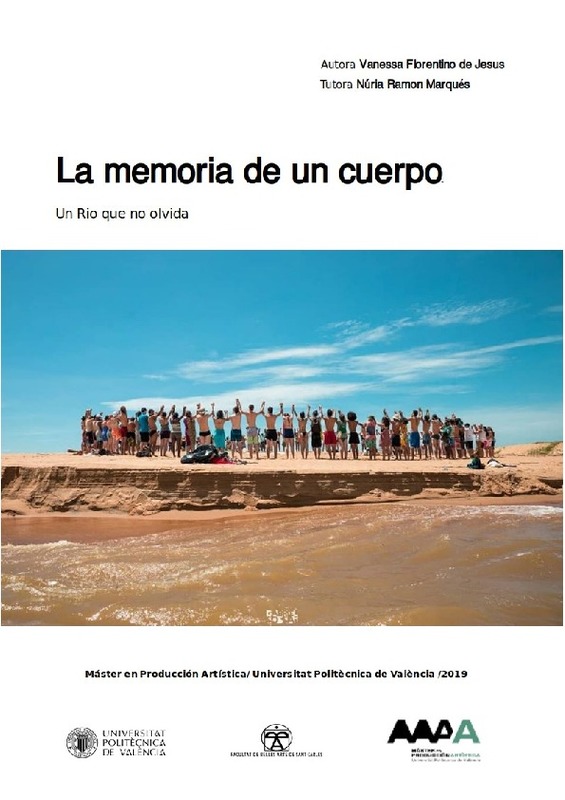JavaScript is disabled for your browser. Some features of this site may not work without it.
Buscar en RiuNet
Listar
Mi cuenta
Estadísticas
Ayuda RiuNet
Admin. UPV
La memoria de un cuerpo. Un Río que no olvida
Mostrar el registro sencillo del ítem
Ficheros en el ítem
| dc.contributor.advisor | Ramón Marqués, Luisa Nuria
|
es_ES |
| dc.contributor.author | Florentino de Jesus, Vanessa
|
es_ES |
| dc.date.accessioned | 2019-11-12T16:09:49Z | |
| dc.date.available | 2019-11-12T16:09:49Z | |
| dc.date.created | 2019-09-12 | |
| dc.date.issued | 2019-11-12 | es_ES |
| dc.identifier.uri | http://hdl.handle.net/10251/130858 | |
| dc.description.abstract | [EN] All people are powerful and have many powers. But many times in from of a catastrophe those powers are forgotten or lost. We believe in artistic practice as an element of affective restoration, a basic element of social transformation, mainly together with communities that find themselves in situations of crisis, vulnerability and invisibility, caused by wars, social inequality or environmental catastrophes. . Faced with the environmental catastrophe of the Rio Doce, we share the practical experience of artistic creation in some of the communities of the Doce River basin, between the provinces of Espirito Santo and Minas Gerais, in Brazil. An artistic practice that has the intention of provoking empathy through the listening of the affective memories with the Rio with the idea of an affective regeneration, that allows a possibility of the person to feel part of the world again. | es_ES |
| dc.description.abstract | [ES] Todas las personas son potentes y tienen muchas potencias. Pero muchas veces en descorrer de una catástrofe esas potencias son olvidadas o perdidas. Creemos en la practica artística como elemento de restauración afectiva, elemento base de transformación social, principalmente junto a comunidades que encuentran se en situaciones de crisis, vulnerabilidad e invisibilidad, ocasionadas tanto por guerras, desigualdad social o catástrofes ambientales. Frente a la catástrofe ambiental del Rio Doce, compartimos la experiencia práctica de la creación artísticas en algunas de las comunidades de la cuenca del Rio Doce, entre las provincias de Espirito Santo y Minas Gerais, en Brasil. Una práctica artística que tiene la intención de provocar empatia a través de la escucha de las memorias afectivas con el Rio con la idea de una regeneración afectiva, que permita una posibilidad de la persona se sentir parte del mundo otra vez. | es_ES |
| dc.language | Español | es_ES |
| dc.publisher | Universitat Politècnica de València | es_ES |
| dc.rights | Reconocimiento - No comercial (by-nc) | es_ES |
| dc.subject | territorio | es_ES |
| dc.subject | afecto | es_ES |
| dc.subject | catástrofe | es_ES |
| dc.subject | regeneración | es_ES |
| dc.subject | performance | es_ES |
| dc.subject | resistencia | es_ES |
| dc.subject | resiliencia | es_ES |
| dc.subject.classification | HISTORIA DEL ARTE | es_ES |
| dc.subject.other | Máster Universitario en Producción Artística-Màster Universitari en Producció Artística | es_ES |
| dc.title | La memoria de un cuerpo. Un Río que no olvida | es_ES |
| dc.type | Tesis de máster | es_ES |
| dc.rights.accessRights | Abierto | es_ES |
| dc.description.bibliographicCitation | Florentino De Jesus, V. (2019). La memoria de un cuerpo. Un Río que no olvida. http://hdl.handle.net/10251/130858 | es_ES |
| dc.description.accrualMethod | TFGM | es_ES |
| dc.relation.pasarela | TFGM\103550 | es_ES |
Este ítem aparece en la(s) siguiente(s) colección(ones)
-
BBAA - Trabajos académicos [5086]
Facultad de Bellas Artes






